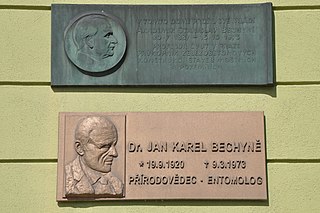George Charles Champion was an English entomologist specialising in the study of beetles. He was born in Walworth, South London, and the eldest son of George Champion.
Rhysodinae is a subfamily in the family Carabidae. There are 19 genera and at least 380 described species in Rhysodinae. The group of genera making up Rhysodinae had been treated as the family Rhysodidae in the past, and subsequent DNA analysis then placed it within Carabidae, where it was sometimes treated as the tribe Rhysodini, but the most recent analyses place it as a subfamily in a clade along with subfamilies Paussinae and Siagoninae, forming a sister to the remaining Carabidae.

Clinidium is a genus of wrinkled bark beetles in the subfamily Rhysodinae. Most species are Neotropical, but some occur further north in North America and there is also one species in Europe and one in Japan. Two species are known from Miocene amber.
Clinidium bechyneorum is a species of ground beetle in the subfamily Rhysodinae. It was described by R.T. Bell & J.R. Bell in 1985. It is known from its type locality in Carabobo, northern Venezuela. An additional specimen that might represent a distinct species is from the neighboring Aragua state. The species is named for J. Bechyne and B. Bechyne, collectors of the type series and many other Clinidium specimens.
Clinidium excavatum is a species of ground beetle in the subfamily Rhysodinae. It was described by R.T. Bell & J.R. Bell in 1985. It is known from its type locality in Carabobo, northern Venezuela. Clinidium excavatum measure 6.5–6.8 mm (0.26–0.27 in) in length.
Clinidium smithsonianum is a species of ground beetle in the subfamily Rhysodinae. It was described by R.T. Bell & J.R. Bell in 1985. Clinidium smithsonianum is known from Dominica. It measures 5–6.1 mm (0.20–0.24 in) in length.
Clinidium erwini is a species of ground beetle in the subfamily Rhysodinae. It was described by Ross Bell & J.R. Bell in 2009 and named after entomologist Terry Erwin. It is endemic to Costa Rica and occurs in the forests of the Caribbean coast and inland to at least 400 m (1,300 ft) above sea level.
Clinidium apertum is a species of ground beetle in the subfamily Rhysodinae. It was described by Edmund Reitter in 1880. It is endemic to the eastern United States.
Clinidium chevrolati is a species of ground beetle in the subfamily Rhysodinae. It was described by Edmund Reitter in 1880. It is known with some certainty only from Pico Turquino in the Sierra Maestra, Cuba—the type locality of Clinidium turquinense—the type locality of Clinidium chevrolati, "Neu Granada", seems to be in error.
Clinidium boroquense is a species of ground beetle in the subfamily Rhysodinae. It was described by R.T. Bell in 1970. It is endemic to Puerto Rico.
Clinidium chiolinoi is a species of ground beetle in the subfamily Rhysodinae. It was described by R.T. Bell in 1970. It is endemic to Jamaica. Clinidium chiolinoi measure 4.4–5.6 mm (0.17–0.22 in) in length.
Clinidium darlingtoni is a species of ground beetle in the subfamily Rhysodinae. It was described by R.T. Bell in 1970. It is endemic to Jamaica.
Clinidium valentinei is a species of ground beetle in the subfamily Rhysodinae. It was described by R.T. Bell in 1970. It is endemic to the Appalachian Mountains in the eastern United States, from northern Alabama to southwestern Pennsylvania.
Clinidium mathani is a species of ground beetle in the subfamily Rhysodinae. It was described by Antoine Henri Grouvelle in 1903. Originally known from the Amazon Basin of Brazil—its type locality is in the Amazonas State, near the border with Peru and Colombia, and there is another record from Amapá—it is now also known from the Colombian Andes in the Cordillera de los Picachos National Natural Park (Caquetá) and from near Inzá (Cauca). It is named after collector of the holotype, M. de Mathan.
Clinidium canaliculatum is a species of ground beetle in the subfamily Rhysodinae. It was described by O.G. Costa in 1839. It is found in southern Italy and in Greece and is an obligate saproxylic species associated with old-growth forests, with preference to wet biotopes with well-decayed wood. Clinidium canaliculatum measure 6–7.5 mm (0.24–0.30 in) in length.
Clinidium cavicolle is a species of ground beetle in the subfamily Rhysodinae. It was described by Louis Alexandre Auguste Chevrolat in 1873. It is known from Colombia; there is an uncertain record from Brazil too. There is uncertainty as regards to the origin of the type specimen(s) as the original label refers to "Nova-Grenata, Bogoto", probably referring to Bogota. What is now designated as the lectotype is from Ocaña, Norte de Santander. The other syntype, probably of "the other sex", matches Chevrolat's description less well and was described in 1985 as Clinidium humile.
Clinidium guatemalenum is a species of ground beetle in the subfamily Rhysodinae. It was described by David Sharp in 1899. It is endemic to Guatemala.
Clinidium planum is a species of ground beetle in the subfamily Rhysodinae. It was described by Louis Alexandre Auguste Chevrolat in 1844. It is probably endemic to Guadeloupe ; a female supposedly from "Mexico" probably represents another species and may have been mislabeled. Clinidium planum measure 5.3–6.3 mm (0.21–0.25 in) in length.

Ross Taylor Bell was an American entomologist with particular interest in the invertebrate natural history of Vermont, United States, and carabid beetles. Together with his wife, Joyce Bell, his work at the University of Vermont was largely taxonomic, where they described more than 75% of the rhysodine species known to science. Ross also wrote a number of seminal papers in his chosen field.

Jan Karel Bechyně was a Czech entomologist and a leading authority on leaf beetles (Chrysomelidae). He was the son of photographer Jan Bechyně and nephew of architect Stanislav Bechyně.


